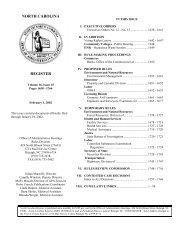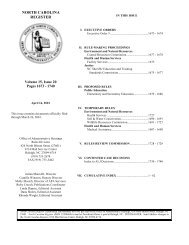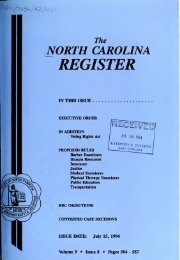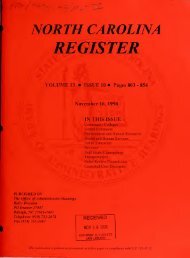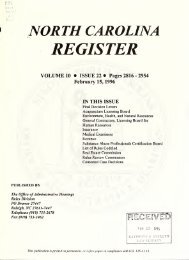NC Register Volume 9 Issue 15 - Office of Administrative Hearings
NC Register Volume 9 Issue 15 - Office of Administrative Hearings
NC Register Volume 9 Issue 15 - Office of Administrative Hearings
You also want an ePaper? Increase the reach of your titles
YUMPU automatically turns print PDFs into web optimized ePapers that Google loves.
—<br />
—erosion— problem s<br />
—<br />
s<br />
—<br />
—<br />
PROPOSED RULES<br />
commercial fishing and emergency access for<br />
beach rescue services. Private property rights to<br />
oceanfront properties including the right to protect<br />
that property in ways that are consistent with<br />
public rights should be protected.<br />
(b) Nonstructural Erosion response measures<br />
designed to minimize the loss <strong>of</strong> private and public<br />
resources to erosion should be ate— preferred<br />
s olution s—te<br />
provided— uch<br />
measures—afe economically, socially, ef and<br />
environmentally justified. Preferred nonstructural<br />
control response measures for shoreline erosion<br />
shall include but not be limited to AEC rules,<br />
land<br />
use planning and land classification, establishment<br />
<strong>of</strong> building setback lines, building relocation.<br />
subdivision regulations and management <strong>of</strong><br />
vegetation. When structural control s arc selected<br />
in developing alternative plans for erosion control<br />
a clear rationale should be presented and tho se<br />
structural control measures which have the lca3t<br />
effect on natural processes should be given prime<br />
consideration.— Note: For the purpo se <strong>of</strong> thi s<br />
policy beach nourishment projects arc included<br />
with traditional structural control measures such as<br />
revetments.— The reason for tor thi tni s is that beach<br />
nouri shment projects are land disturbing activities<br />
that can drastically alter the estuary (as a borrow<br />
area), the barrier island (through which pipelines<br />
will be laid) and the beach and ncarshore (through<br />
the replacement <strong>of</strong> aquatic bottoms with dry sand).<br />
(e) Efforts to permanently stabilize the location<br />
<strong>of</strong> the shoreline by mas s ive seawalls and similar<br />
protection devices which do not preserve public<br />
trust rights should not be allowed.— The attendant<br />
environmental damages and public economic costs<br />
are unacceptably high.— Temporary measures to<br />
counteract erosion, such as beach nourishment,<br />
sandbag bulkheads, and beach pushing, should be<br />
allowed, but only to the extent neces sary to protect<br />
property for a short period <strong>of</strong> time until threatened<br />
structures may be relocated or until the effects <strong>of</strong><br />
a short term erosion event arc reversed.— In all<br />
eases, temporary stabilization measures must be<br />
compatible with public use and enjoyment <strong>of</strong> the<br />
beach.<br />
(c) The replenishment <strong>of</strong> sand on ocean beaches<br />
can provide storm protection and a viable alternative<br />
to allowing the ocean shoreline to migrate<br />
landward threatening to degrade public beaches<br />
and cause the loss <strong>of</strong> public facilities and private<br />
property. Experience in North Carolina and other<br />
states has shown that beach restoration projects can<br />
present a feasible alternative to the loss or massive<br />
relocation <strong>of</strong> oceanfront development. In light <strong>of</strong><br />
this experience, beach restoration and sand renourishment<br />
and disposal projects may be allowed<br />
when:<br />
(1) Erosion threatens to degrade public<br />
beaches and to damage public and<br />
private properties:<br />
(2) Beach restoration, renourishment or<br />
sand disposal projects are determined to<br />
be socially and economically feasible<br />
and cause no significant adverse environmental<br />
impacts;<br />
(3) The project is determined to be consistent<br />
with state policies for shoreline<br />
erosion response and state use standards<br />
for Ocean hazard and Public Trust<br />
Waters Areas <strong>of</strong> Environmental Concern<br />
and the relevant rules and guidelines<br />
<strong>of</strong> state and federal review agencies.<br />
When the conditions set forth in this Paragraph can<br />
be met, the Coastal Resources Commission supports,<br />
within overall budgetary constraints, state<br />
financial participation in Beach Erosion Control<br />
and Hurricane Wave Protection projects that are<br />
cost-shared with the federal government and<br />
affected local governments pursuant to the federal<br />
Water Resources Development Act <strong>of</strong> 1986 and the<br />
North Carolina Water Resources Development<br />
Program (G.S. 143-2<strong>15</strong>.70-73).<br />
(d) The following are required with state involvement<br />
(funding or sponsorship) in beach<br />
restoration and sand renourishment projects:<br />
(1) The entire restored portion <strong>of</strong> the beach<br />
shall be in permanent public ownership:<br />
(2) It shall be a local government responsibility<br />
to provide adequate parking,<br />
public access, and services for public<br />
recreational use <strong>of</strong> the restored beach.<br />
(e) Temporary measures to counteract erosion,<br />
such as the use <strong>of</strong> sandbags and beach pushing,<br />
should be allowed, but only to the extent necessary<br />
to protect property for a short period <strong>of</strong> time until<br />
threatened structures may be relocated or until the<br />
effects<br />
In all<br />
<strong>of</strong> a short-term erosion event are reversed.<br />
cases, temporary stabilization measures must<br />
be compatible with public use and enjoyment <strong>of</strong><br />
the beach.<br />
(f) The following are required with state in<br />
volvcmcnt (funding or sponsorship) in<br />
oceanfront<br />
erosion control projects!<br />
(4-) Aa assessment— consistent—with—the<br />
North Carolina Environmental Policy<br />
Act (SEPA) shall determine that there<br />
will<br />
impacts;<br />
be no unacceptable cnvironmcBtal<br />
$¥) The entire restored portion <strong>of</strong> the beach<br />
1193 NORTH CAROLINA REGISTER November 1, 1994 9:<strong>15</strong>




